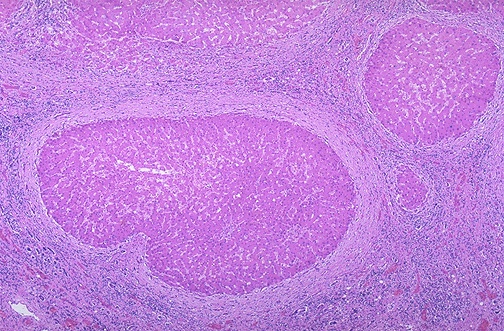
Liver Cirrhosis

Click to see other slides: [1]
1. What has
happened to the liver to reach such a pathological state?
Pathological
state: liver cirrhosis
It is the end result of continued damage to liver cells (hepatocytes) due to a
variety of causes.
Examples of these causes include alcoholism and hepatitis B and C.
2.
Describe the key
histopathological features.
Wholesale disruption of liver
architecture
Formation of nodules of regenerating hepatocyes
separated by fibrous bands.
Fibrous bands may connect portal areas.
3.
What are the main
histopathological effects?
2
main effects:
a) Disordered
hepatocyte function leading to:
-
decreased production of plasma proteins resulting in oedema
- decrease
detoxification �
toxic metabolites not removed efficiently, e.g. NH3 toxic in brain
(encephalopathy)
- jaundice
b) Disturbance
of blood flow through liver from portal veins to hepatic veins (vascular
obstruction) �
increased portal venous pressure (portal hypertension) �
portal systemic anaestomosis open up � may result in large dilated thin walled veins
e.g. Oesophageal varices � veins may rupture �
cough out blood.
4. The panel
of liver function tests to assess the integrity of the patients� liver was
performed. Comment on the expected
changes (normal, ↑ or ↓)
a)
total bilirubin (conjugated and unconjugated)
↑
b)
ALT
↑
c)
AST
↑
d)
GGT
↑
e)
ALP
↑
f)
Total protein (albumin, globulin)
↓
g)
Prothrombin time, APTT
↑
5. State T or F
In
the liver, cirrhosis
-
usually precedes fatty change
F (fatty change precedes cirrhosis)
-
is usually reversible after a period of
F (cirrhosis is an irreversible process)
abstinence
from alcohol
-
is often evident on the gross specimen
T (can see the nodules)
never affects hepatic function F (see 3 point a)
<< PREVIOUS INDEX NEXT SLIDE >>
Copyright � Joseph Ong 2003